Drum Noise Reduction [Ultimate Guide]
Drum noise reduction is something you’ll have to deal with at some point or another. Whether it be; a sound limiter at a venue, your band members getting annoyed during rehearsal, drum tracking or even volume restrictions at home. Here are some tips to help you with drum noise reduction – including examples on how to dampen a snare drum and reduce cymbal volume.
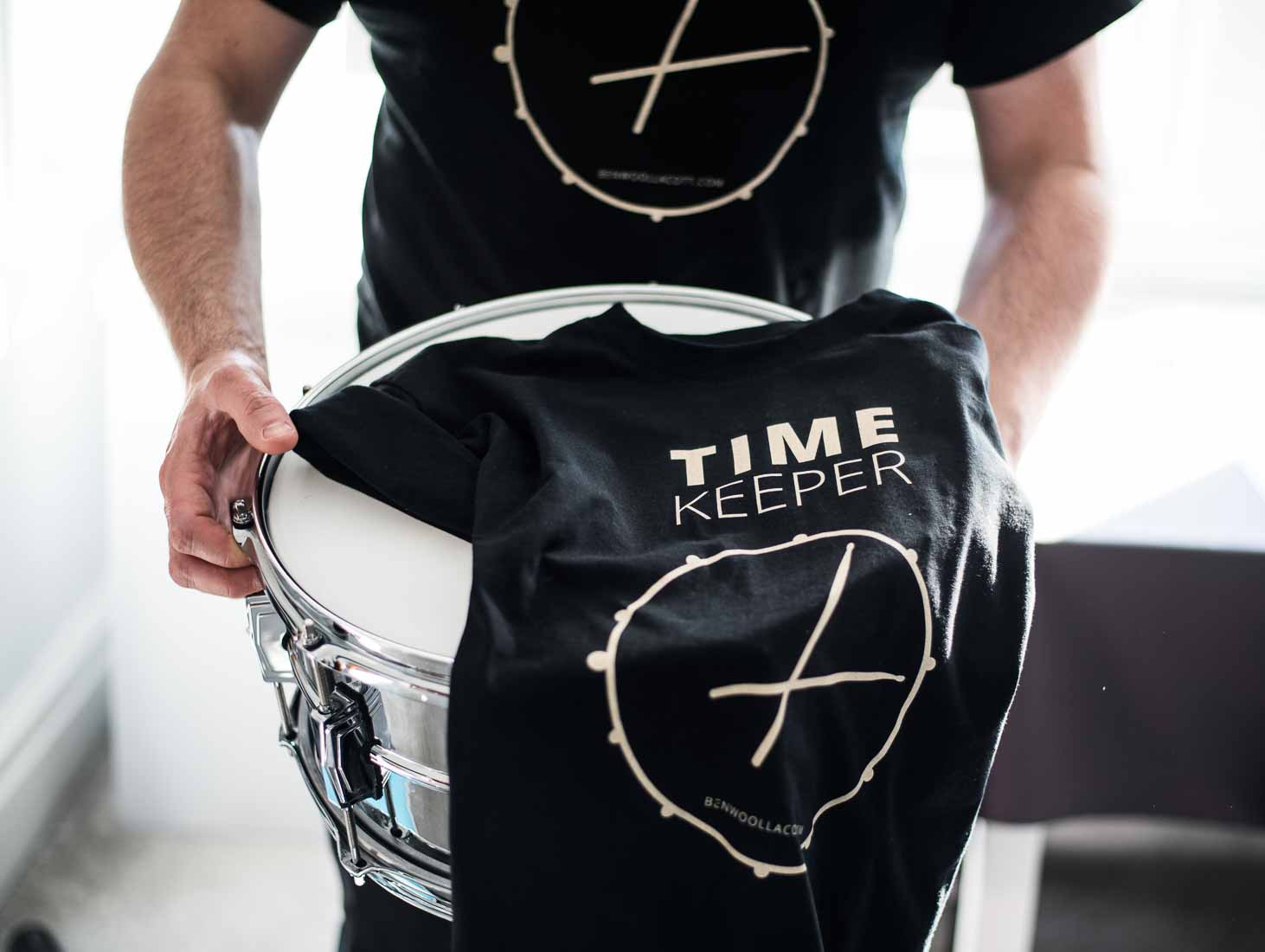
How to Reduce Drum Noise?
Unfortunately there’s no simple answer to ‘how to reduce drum noise?’. Drums are an acoustic instrument and don’t have a volume dial. So, inevitably it will be up to YOU to control your dynamics or how you play the instrument. Being that a drum is an acoustic instrument it’s also at the mercy of the acoustics in the room they’re in. So again, it’s up to you to adapt.
Of course there are other variables to contend with such as; what type of drums are you playing, what size drums are you playing, your choice of drum heads, your choice of cymbals and sticks, the style of music you’re playing, the type of room or space you are in and so-on. Using these different drum noise reduction techniques have helped me reduce drum noise over the years and will certainly help you.
Dampen a Snare Drum
‘Dampen’ is a term used to reduce the sound waves produced by your instrument. This also reduces the volume because the energy of the wave amplitude is lessened at it’s source.
Your snare drum is the most consistent sound source in your drum kit and can be the loudest. So you can DIY dampen your snare drum with:
- a spare T-shirt
- a newspaper
- an A4 piece of paper
- a towel
- an internal (or external) tone control
- an upside down drumhead
- Big Fat Snare products
- a wallet
- O-rings
- moon gel
- pieces of Gaffa Tape
When you dampen a snare drum and strike it in the centre of the drum head (with less velocity) you’ll generate a quieter staccato sound. You’ll also notice that the pitch will lower as-well-as the volume being reduced. Furthermore, this technique can be used on your Tom Toms also.
Back in the 1960’s Ringo Starr sometimes used tea towels over his drum kit with the Beatles. Indeed that may have been for a specific sound, but it works just as well when you want to dampen a drum.
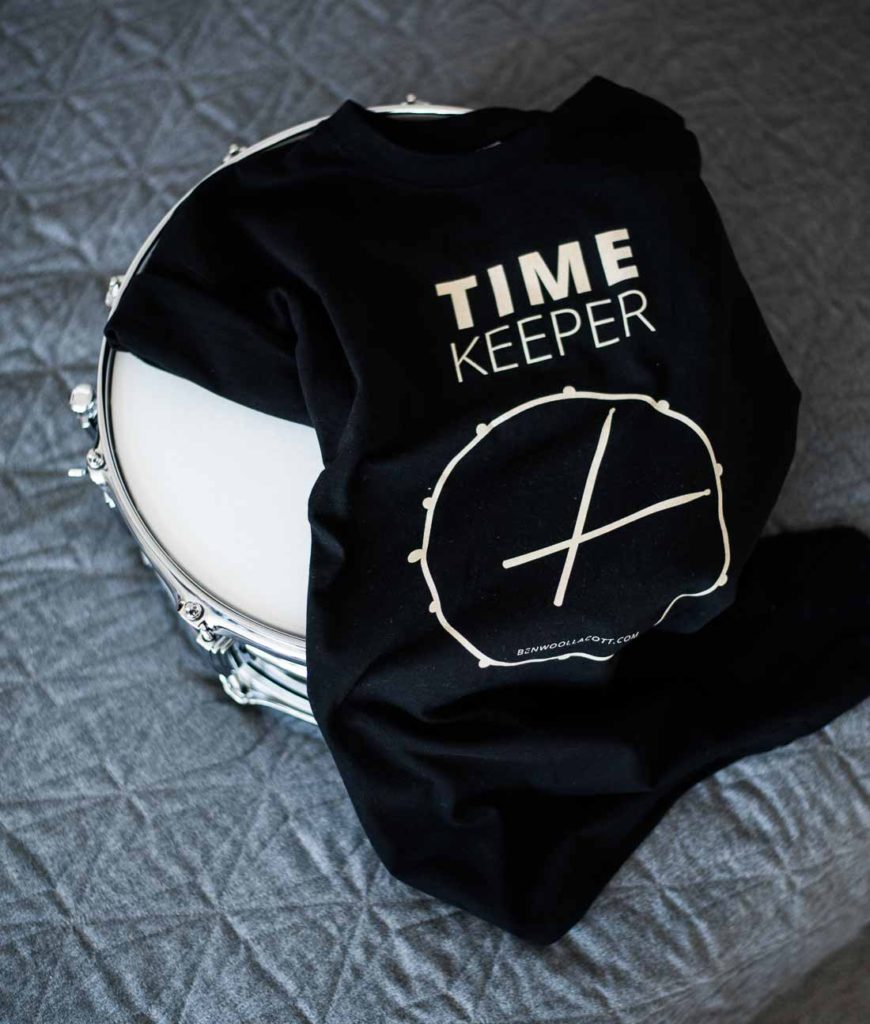
Any t-shirt will do to dampen a snare drum or whatever item of clothing you’ve had flung at you during gigs…. 😉
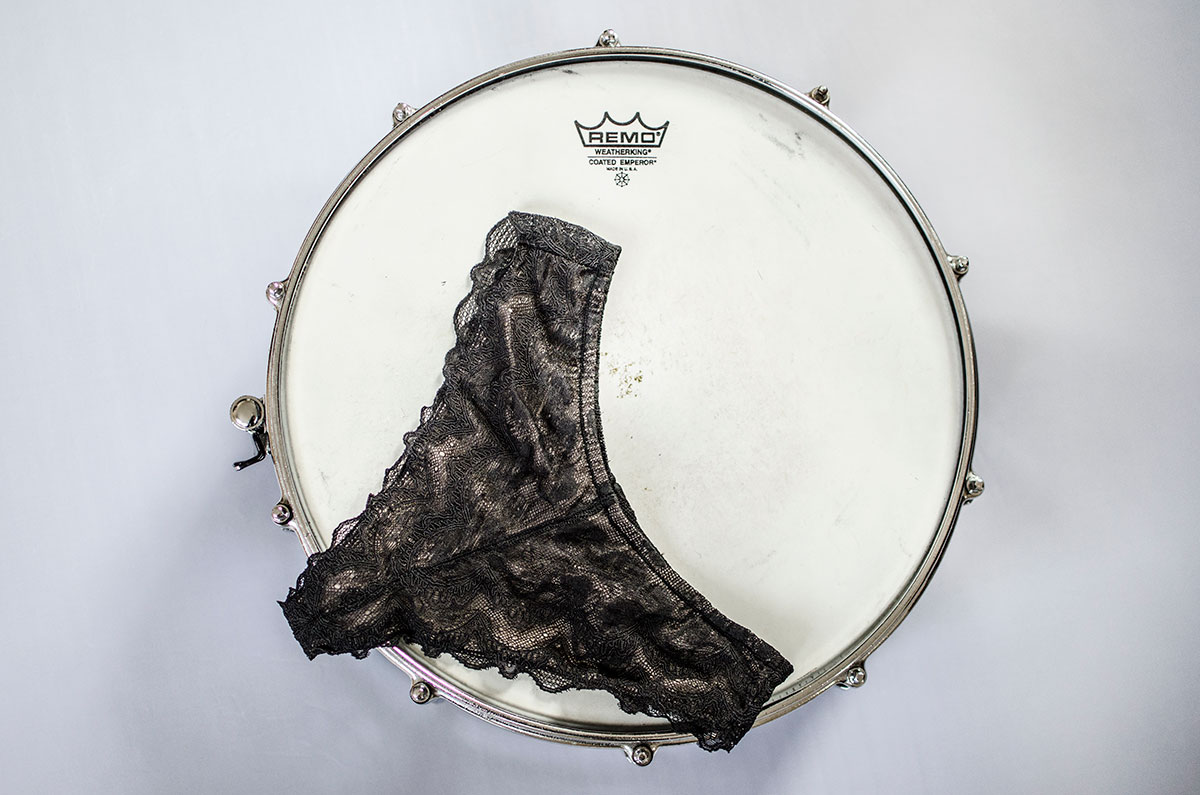
Also you can try wallets to dampen a snare drum. This technique seems to be popular these days.
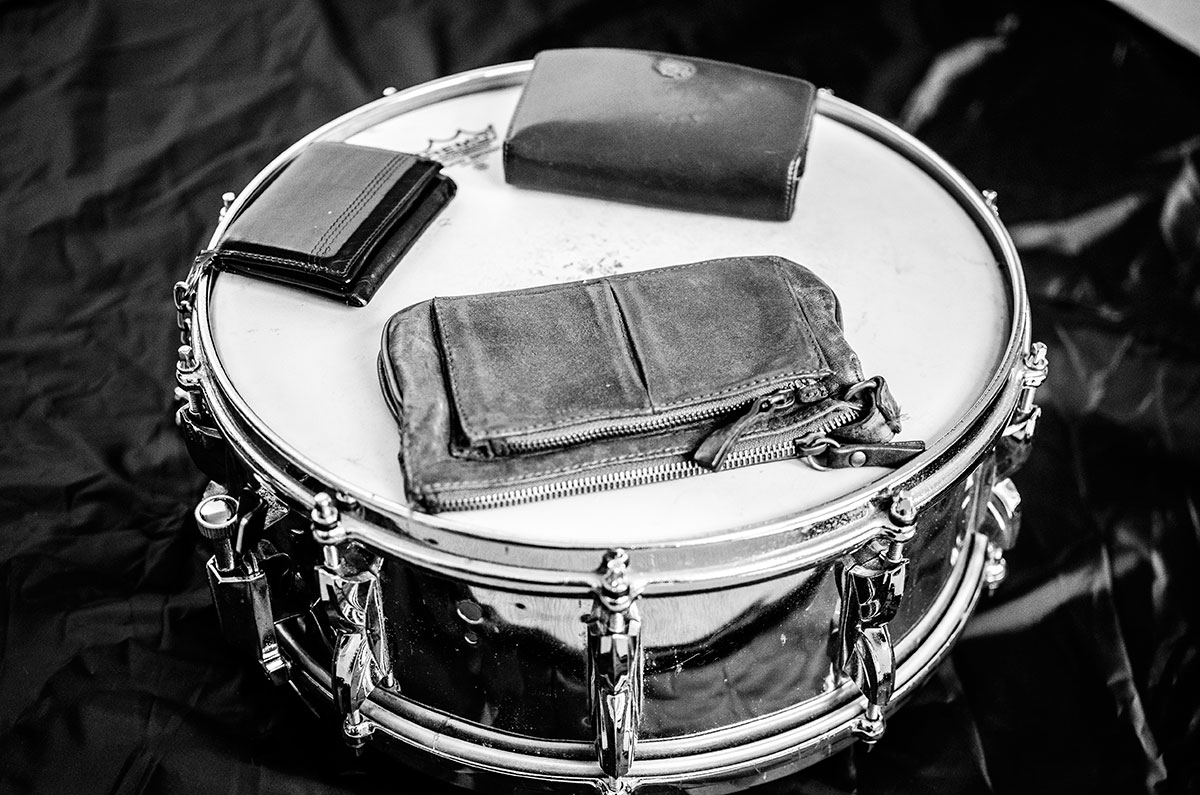
Reduce Cymbal Volume
Some cymbals are designed to be loud and bright with lots of sustain – they’re specifically designed that way to cut through loud music. Other types of cymbals are designed to be darker / dryer sounding with less sustain. These tend to be preferred by drummers playing jazz for example. Whichever set of cymbals you have, these are ways to reduce cymbal volume.
The obvious answer is to not hit them hard. Yes, that’s right, you don’t always have to bash away at them for a visual performance or stress relief. Learn how to play with a lighter touch when striking your cymbals. Another example would be hitting crash cymbals with the TIP of the stick instead of the shoulder / taper. Angling them more towards you and striking them on the bow of the cymbal will also help reduce cymbal volume.
You can also manipulate your cymbal vibration by adding:
- strips of Gaffa Tape
- pieces of Moon Gel
- Cymbal Tuners (magnets).
The overtones will be reduced, subsequently ‘drying’ up the overall sound. As a result you’ll also notice that it will improve stick definition and reduce cymbal volume.
You can always get yourself the Zildjian L80 series low volume cymbals. An excellent choice for when practicing at home.
Drum Stick Choice
Drum stick choice will be a factor in drum noise reduction. You can always use Dowel rods (a.k.a. Hot Rods) instead of conventional drum sticks to help reduce the volume. They help control cymbal volume as-well-as drum kit volume.
Most stick brands have their own version(s) of dowel rods so buy a set you are comfortable with. Similarly, if you are faced with a gig where you have to be no louder than a vacuum cleaner (80 / 85db), try using brushes. Even if you’re playing Rock / Pop tunes. Why not? You’ll have to make it work anyway!
Of course, there’s nothing wrong with using sticks. Some drummers change their stick choice for a thinner model. For example, switching from a 5A to a 7A size stick. By choosing thinner sticks you are lowering the inertia of the stick striking the surface area. Ergo, less sound due to less air being moved around the drum.
Alternatively, you can grip your sticks further up the shaft of the stick to reduce it’s weight striking the surface.
- It takes a heck-of-a-lot-of control to play an entire gig at a low volume with sticks. It’s difficult both mentally and physically. For me it’s something which is still work-in-progress. When using sticks, my preference is to stick (pardon the pun) with my Vic Firth 55A and opt for lower stick heights to strike the drum. Otherwise, Hot Rods would be my other choice.
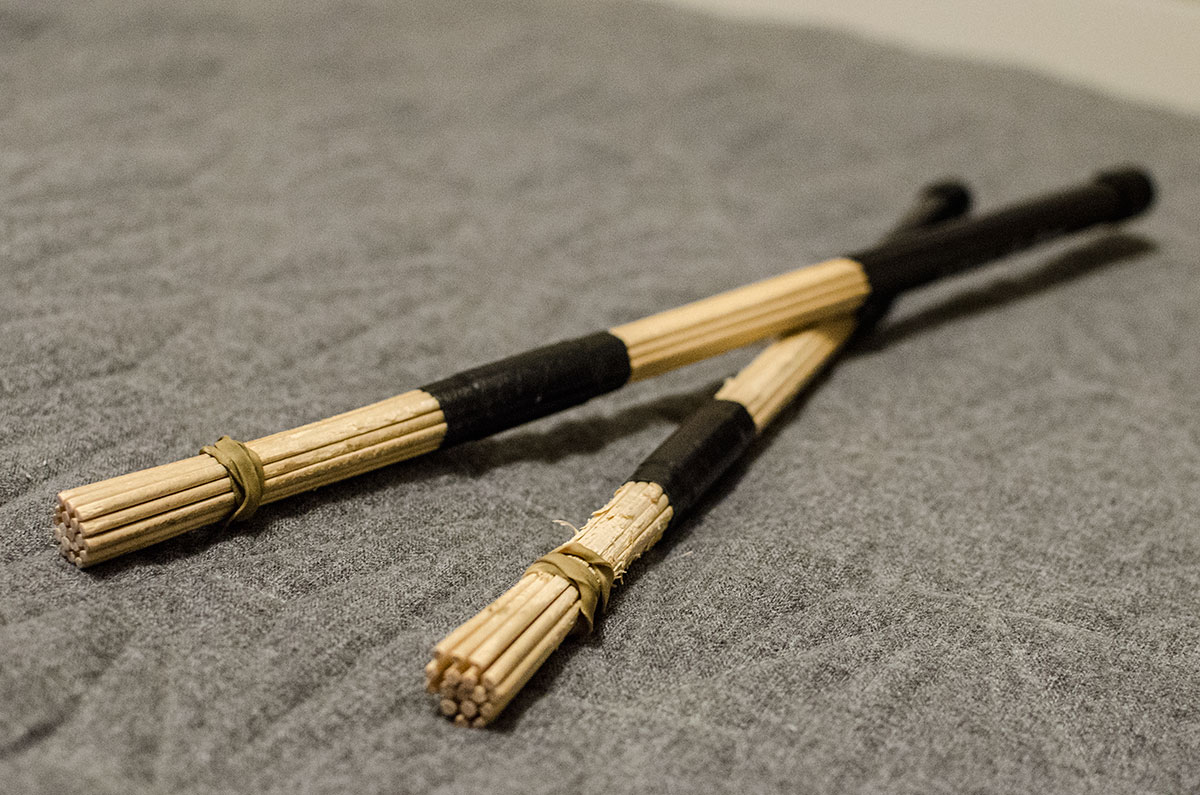
Quieter Way to Practice Drums at Home
There’s a very effective quieter way to practice drums at home. Simply, don’t use the drums! If you check out my video on drumming without drums you’ll see you can practice drumming by tapping your body. Indeed this method is very basic but it’s still effective. By tapping your body instead of a drum kit you can work on such things as; coordination exercises, rudiments and grooves. Not only is this a quieter way to practice drums at home, you can use this method practically anywhere.
Other quiet ways to practice drums at home:
- Get yourself a practice pad The most efficient way to practice your rudiments. Generally it’s a rubber mat on top of a wooden base but these can vary.
- Practice playing quieter Yes drums are loud and fun to play but remember – they’re also a musical instrument. When the adrenaline is flowing, it’s easy to lose oneself in the moment and lose concentration with dynamics. So, being aware of your volume level is an art. Reducing drum volume usually comes with experience and a bit of self awareness.
- Use Mesh Heads A fantastic invention. Mesh drum heads enable the drummer to play on an acoustic drum kit and still have ‘the feel’ of standard drum heads only without the volume. By leaving the resonant heads on, you still get the tone out of the drum. Therefore a great alternative for the real thing
- Drum Mutes These are (generally) rubber pads that fit snuggly onto the surface of the drum head or cymbals. If you want to make them yourself – find an old carpet with a rubber base and cut them to fit your drums. They’ll act as a dampening tool. Due to the weight and more absorbing nature of rubber, they deaden the sound sufficiently.
- Use a Blanket / Duvet My very first drum kit had a blankets draped all over it to reduce the noise. Possibly my parent’s idea…(?) Still it’s a basic, yet very effective method for drum noise reduction.
My First Drum Teacher’s Technique
My first drum teacher’s technique was and still is amazing. You could stand right next to him and not be deafened whilst he played. Moreover, he made the drums SOUND nice. I believe it had something to do with him learning to play the drums without any ear protection in the 1960’s. In any case, It resulted in him having a better touch on the instrument.
The great advantage of playing this way is that you’ll always have headroom to play louder – should you need it.
How to Quieten Drums for Band Practice
How to quieten drums for band practice is the same as the options mentioned previously. Firstly, consider the size of the room you are in. If you’re in a small rehearsal room with a small PA system, you don’t have to play at STADIUM LEVEL volume. Fun as it may be, you’ll likely cause an unpleasant rehearsal for the others because they won’t be able to hear themselves. Dampen your drums if necessary and proceed with the practice. Remember, it’s easier to play louder at a gig should you need to.
However, nowadays you’ll hear about musicians rehearsing with IEM (In Ear Monitors). Effectively they’ll have control of their own music levels and also have protection from outside volume – such as the drums. So, you can play like you would at a gig. That said, you’ll lose nothing by having the option of playing quieter.
Make Drums Quieter on Stage
It’s tricky when reducing drum volume on stage but here are some examples:
- Use Electronic Drums The advantage of using electronic drums is that they have a volume dial that you can turn up or down. So no matter how hard you play, you can control your volume level. This option is definitely worth mentioning as the leading brands (Roland or Yamaha) are making huge leaps and bounds replicating the sounds of acoustic drum kits.
- Perspex Screens Perspex screens that shield you from the rest of the stage/band, or rather, them from you. Sometimes referred to as the ‘Screens of Shame’ these see-through perspex screens are good at reducing drum volume. Some even surround the drummer entirely and include a ceiling. Effectively becoming an isolation booth.
- Use Mesh Heads and Triggers Add triggers and mesh heads to your acoustic drums. It’s similar to using electronic drum kits. The mesh heads focus on reducing drum volume. The triggers will react to the vibrations caused by striking the drum. That, in turn, will trigger a drum sound from your drum brain.
- Use Smaller Drums Because the sizes are smaller than a regular drum kit. There are several arguments for this mainly because they shift less air. But, another argument is that the LIGHTER the drum the quieter it is due to it’s (lack of) density. Whichever the reason, if you peruse my blogs, you’ll find how to make your own ‘club’ style drum kit. This was achieved by amending a smaller, children’s drum set; it certainly beats playing a cajon for smaller gigs! Highly recommend.
- Play Lighter If your playing is generally lighter in velocity (the speed of your stroke), the overall volume will be less; especially when reducing cymbal volume. N.B. Admittedly this doesn’t always work for heavier, energetic styles of music.
Muffle Drums for Playback Gig
The easiest and most common way to muffle drums for a playback gig is to use drum mutes. These dampen all drums and especially dampen a snare drum.
Also, when miming drums during a live broadcast you’ll often see drummers using deadened cymbals or dead cymbals to reduce cymbal volume. Effectively they’re 2 cymbals stuck together. Therefore hardly any sound is generated other than the initial contact of the stick onto the surface. See video below –
Conclusion
There you have it; basic (if not obvious) ways to help with drum noise reduction. Mainly focus on dampening the snare drum and reduce cymbal volume as you’ll be playing those instruments the most.
Noteworthy (other) options include playing: a cajon or various hand percussion instruments.
Finally, whichever you choose, good luck incorporating drum noise reduction. May the size, shape of a room or sound limiters never hinder you from enjoying your gig or practice time.
Do you have any other tips on reducing drum volume? Leave them in the comments section below.
photos: Ula Burgiel, ulaburgiel.com

6 Comments
Join the discussion and tell us your opinion.
The fabric tip has the additional advantage of eliminating the chance of a guitar or bass buzzing your snares with harmonics as tends to happen in acoustically active rooms. For my part adrenaline usually manifests in speed rather than volume, but as Ben pointed out, I too learned to play in an 8′ x10′ room with a concrete floor and wood panel walls without ear protection. I spent all my early years trying to supress the sound, tone and sustain.
Thanks for that Matt!
Interesting stuff! I’ve found careful application gaffa to the bottom head can really help. It seems – I don’t know – that different lengths and putting a flap in the tape, can really help stop toms cutting through without killing the feel; you can tune the damping to the drum – more gaffa is not necessarily more effective. Only good where restrictions aren’t that severe. Preferred approach is the Roland, which is only good if you have access to one
Yes the ol’ gaffa, where would we be without it?
I’ll throw this out for those of a stout heart. Feminine protection products work extraordinarily well. They have adhesive pre-applied, are soft, and made to absorb. Generally on placed about 1/3 in from the rim will kill all the tin and thunder but leave some decent resonant mids. You may find your floor tom cries for no reason but side effects are inevitable.
I hear floor toms can get help from support bras.